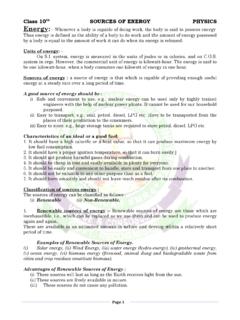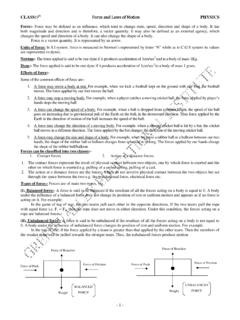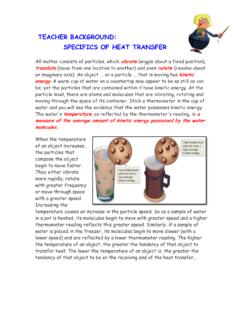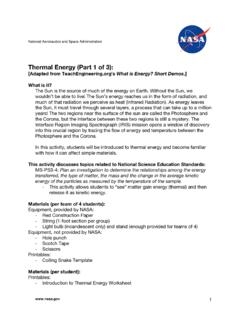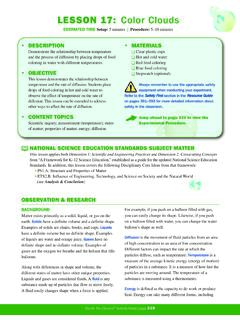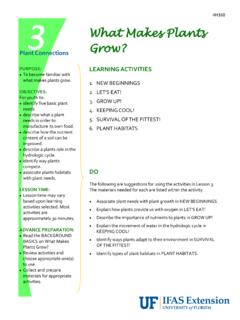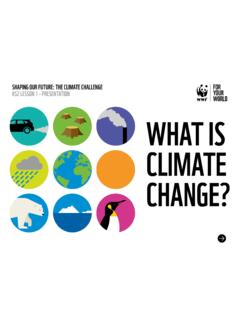Transcription of BIOLOGY NATURAL RESOURCES CLASS 9th
1 Please purchase VeryDOC DOC to Any Converter on to remove this watermark. VeryPDF WaterMark 1 of 12. BIOLOGY NATURAL RESOURCES CLASS 9th .. NATURAL RESOURCES : A resource has been defined as : Any means of attaining given ends. It can be also defined as a source of supply or support generally held in reserve. A resource satisfies human wants. Water, air sun shine, land soil, forests, wildlife, fishes, minerals and power RESOURCES all are useful to man. All basic needs of food, shelter and clothing are supplied by NATURAL RESOURCES on earth. The stocks of nature , useful to man kind are called NATURAL RESOURCES . NATURAL RESOURCES are the components of atmosphere, hydrosphere and lithosphere. TYPES OF NATURAL RESOURCES :- On the basis of abundance and availability NATURAL RESOURCES can be broadly classified into a) Inexhaustible. These are present in plenty and cannot be exhausted by man's consumption viz.
2 Air, sand, clay, water, solar radiation etc. Although air will never become limiting, its quality can be affected due to continuous increase in human population. b) Exhaustible. The stock of these RESOURCES in nature is limited. Exhaustible RESOURCES are further divided into: (i) Renewable (ii) Non-renewable. I) Renewable RESOURCES . Are those which are being continuously consumed by man but renewed by nature water, wood, NATURAL pastures , soil and living organisms, forests, wild life etc. The RESOURCES reappear by the quick replacement, recycling and reproduction in a particular time. II) Non-renewable RESOURCES . They are not renewable after use and are not replenished by nature fossil fuels minerals viz. copper, iron, etc. Fossil fuels include coal, petroleum etc. ATMOSPHERE :- The Gaseous envelope surrounding the earth is called atmosphere. In atmosphere, about 95% of the total air is present upto the height of about 20 Km above earth's surface.
3 The remaining 5% is present upto about 280 Km height. The earth upto the height of about 300 Km above earth's surface is surrounded by air. Air is formed of a mixture of different gases in different proportions. These various gases are nitrogen ( ), oxygen ( ) and carbon dioxide ( ). Air besides these gases also contains water vapours, industrial gases, dust smoke particles, microorganisms etc. ROLE OF ATMOSPHERE:- 1. Air functions as a medium for locomotion insects, birds etc. 2. Ozone layer of atmosphere protects the living organisms from harmful radiations of sun. 3. Air is the source of oxygen, carbon dioxide and nitrogen required for various metabolic activities of living beings. 4. It helps in dispersal of spores, pollen, seeds etc. Demo Please Watermark purchase VeryDOC DOC to Any Converter on to remove this watermark. Page 101 of 112 Filename= NATURAL RESOURCES Date=11/23/2012 Time=10:38:25 AM.
4 Please purchase VeryDOC DOC to Any Converter on to remove this watermark. VeryPDF WaterMark 2 of 12. BIOLOGY NATURAL RESOURCES CLASS 9th . 6. Air transmits sound for communication. 7. Ionosphere reflects the radio waves back to earth for long distance communication due to presence of ions and free electrons in this zone. 8. Burning of fire takes place in presence of oxygen. 9. Specific climatic conditions and water cycle is maintained due to circulation of air. ROLE OF ATMOSPHERE IN CLIMATE CONTROL:- The air is a bad conductor of heat . The atmosphere (envelope of air that surrounds the earth). acts as a protective blanket for the living organisms to exist in the following ways : (i) It keeps the average temperature of the earth fairly steady during the day and even during the course of the whole year. The atmosphere does so by preventing the sudden increase in temperature during the day light hours.
5 Further, during the night, it slows down the escape of heat into the outer space. In contrast, the situation on the moon is quite different which is about the same distance from the sun that the earth is .Moon has no atmosphere and the temperature on the surface of the moon ranges from _190o C to 110oC. (ii) The ozone shield (high concentration of ozone layer about 18-26 km above the surface of earth) of the atmosphere absorbs most of the harmful UV radiations coming from the sun. the excessive heat and rays are reflected back into the outer space by dust particles, water vapours, clouds etc. this results in the earth receiving just the right amount of heat and sun rays, it helps in climate control and allows the living organisms to survive. WINDS:- Moving air is called wind. Movement of air (wind) occurs due to heating of air overland and oceans. Due to more movement of air, exchange of air takes place in between neighbouring places and condition of inversion does not develop.
6 Therefore condition of silent air is necessary. Inversion for air occurs due to difference of thermal conditions over he land surface and upper layers of atmosphere. Air circulation or movement also occurs due to pressure gradient at two different places. Air movement occurs from high pressure region to low pressure region. Difference of air pressure at two places takes place due to difference of temperature at both places. Movement of air takes place by two ways : 1) Longitudinal movement of air (air currents) takes place from high pressure region towards region of low pressure. 2) Movement of air (wind) parallel to the surface of earth. HOW ARE CLOUDS FORMED:- When water bodies are heated with solar radiations during the day, a large amount of water evaporates and goes into the air. Some amount of water vapour also goes into the atmosphere because of various biological activities such as transpiration by plants.
7 The air carrying water vapours also gets heated. This hot air rises up carrying water vapours with it. As the air rises it expands and cools. This cooling causes the water vapour in the air to condense in the form of tiny Demo Please Watermark purchase VeryDOC DOC to Any Converter on to remove this watermark. Page 102 of 112 Filename= NATURAL RESOURCES Date=11/23/2012 Time=10:38:25 AM. Please purchase VeryDOC DOC to Any Converter on to remove this watermark. VeryPDF WaterMark 3 of 12. BIOLOGY NATURAL RESOURCES CLASS 9th . particles act as the nucleus' for these droplets to form around. And enormous collection of tiny droplets of water appears in the form of clouds. These droplets of water, once formed, slowly grow bigger by the condensation of more water droplets. When the droplets have grown big and heavy, they fall down in the form of rain. Occasionally when the temperature of air is very low, precipitation then may occur in the form in the form of snow, sleet or hail.
8 POLLUTION:- Pollution is an undesirable change in physical, chemical or biological characteristics of environment- air, water and soil .this harmfully affect the life or create a potential health hazards to living organisms. Thus pollution is direct or indirect change in any component of biosphere (Earth along with the atmosphere that sustains life is called biosphere.) that is harmful to the living organisms including man. Pollutants are substances that cause pollution. Pollutants may be solid, liquid or gaseous substance present in such concentration that is harmful to the environment. KINDS OF POLLUTIONS:- Pollutants are of two types:- 1) Biodegradable pollutants. Those pollutants which decompose rapidly under NATURAL conditions, , domestic wastes. Their accumulation creates problem, causes bad odour. 2) Non-degradable pollutants. Those materials that do not degrade or degrade very slowly in nature, aluminium cans, mercuric salts, glass pieces, etc.
9 They are not cycled in nature. AIR POLLUTION:- An undesirable change in the physical, chemical or biological characteristics of the air making it harmful for the living organisms (including man) is termed air pollution. In simple words, addition of unwanted and harmful substances in the air or increase in the quantities of constants of air beyond the normal level that affects the living organisms is called air pollution. Agents or substances that pollute the air are called air pollutants. SOURCES OF AIR POLLUTION:- There are two main sources of air pollution: 1) NATURAL sources 2) Man-made sources. 1) NATURAL sources of air pollution:- Number of NATURAL sources do cause air pollution. For instance, volcanic eruptions release toxic gases, ash, and heat in enormous quantities which pollute the air ; electric storms and solar flares produce armful chemicals in the atmosphere; forest fires release harmful gases; dust storms put dust particles in the air and pollute it; decay organic matter produces toxic ammonia gas which pollutes the air ; decay of vegetation matter in marshy places and in coal mines produces marsh gas (methane, CH4) which is a NATURAL air pollutant ; pollen grains, spores, cysts, bacteria are also NATURAL pollutants of the air.
10 2) Man-made sources of air pollution:- Man has been polluting the air ever since he started using fire. Urbanization, industrialization and invention of automobiles as means of transport, all these have speeded up the pollution of air. Over population, deforestation, mining activities, Demo Please Watermark purchase VeryDOC DOC to Any Converter on to remove this watermark. Page 103 of 112 Filename= NATURAL RESOURCES Date=11/23/2012 Time=10:38:25 AM. Please purchase VeryDOC DOC to Any Converter on to remove this watermark. VeryPDF WaterMark 4 of 12. BIOLOGY NATURAL RESOURCES CLASS 9th . also contributing to air pollution. Major harm is being done by burning of fossil fuels (coal, NATURAL gas, petroleum) in automobiles, industries and thermal power plants. Burning of wood, cattle dung cakes, coal and kerosene soil in residential premises also pollute the air. HARMFUL EFFECTS OF AIR POLLUTION:- Air is needed for breathing by humans, other land animals and many aquatic organisms.
